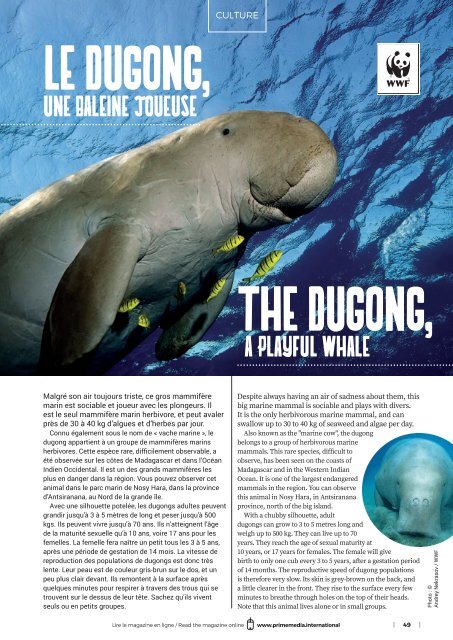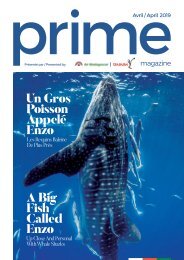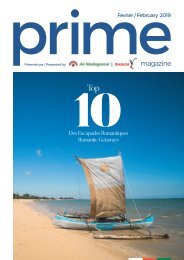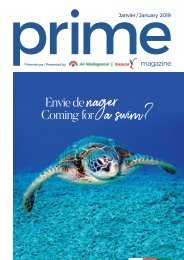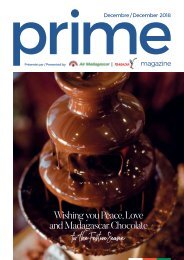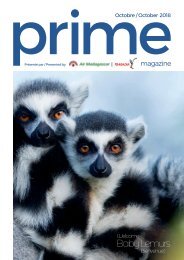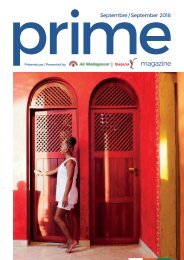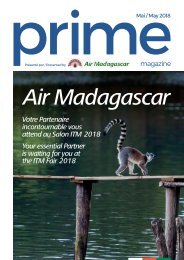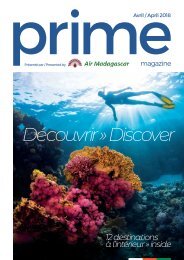PRIME MAG - AIR MAD - JANUARY 2018 - all PAGES - LO-RES
You also want an ePaper? Increase the reach of your titles
YUMPU automatically turns print PDFs into web optimized ePapers that Google loves.
CULTURE<br />
LE DUGONG,<br />
UNE BALEINE JOUEUSE<br />
THE DUGONG,<br />
A PLAYFUL WHALE<br />
Photo © : Istockphoto.com / WWF<br />
Malgré son air toujours triste, ce gros mammifère<br />
marin est sociable et joueur avec les plongeurs. Il<br />
est le seul mammifère marin herbivore, et peut avaler<br />
près de 30 à 40 kg d’algues et d’herbes par jour.<br />
Connu également sous le nom de « vache marine », le<br />
dugong appartient à un groupe de mammifères marins<br />
herbivores. Cette espèce rare, difficilement observable, a<br />
été observée sur les côtes de Madagascar et dans l’Océan<br />
Indien Occidental. Il est un des grands mammifères les<br />
plus en danger dans la région. Vous pouvez observer cet<br />
animal dans le parc marin de Nosy Hara, dans la province<br />
d’Antsiranana, au Nord de la grande île.<br />
Avec une silhouette potelée, les dugongs adultes peuvent<br />
grandir jusqu'à 3 à 5 mètres de long et peser jusqu'à 500<br />
kgs. Ils peuvent vivre jusqu’à 70 ans. Ils n’atteignent l’âge<br />
de la maturité sexuelle qu’à 10 ans, voire 17 ans pour les<br />
femelles. La femelle fera naître un petit tous les 3 à 5 ans,<br />
après une période de gestation de 14 mois. La vitesse de<br />
reproduction des populations de dugongs est donc très<br />
lente. Leur peau est de couleur gris-brun sur le dos, et un<br />
peu plus clair devant. Ils remontent à la surface après<br />
quelques minutes pour respirer à travers des trous qui se<br />
trouvent sur le dessus de leur tête. Sachez qu’ils vivent<br />
seuls ou en petits groupes.<br />
Despite always having an air of sadness about them, this<br />
big marine mammal is sociable and plays with divers.<br />
It is the only herbivorous marine mammal, and can<br />
sw<strong>all</strong>ow up to 30 to 40 kg of seaweed and algae per day.<br />
Also known as the "marine cow", the dugong<br />
belongs to a group of herbivorous marine<br />
mammals. This rare species, difficult to<br />
observe, has been seen on the coasts of<br />
Madagascar and in the Western Indian<br />
Ocean. It is one of the largest endangered<br />
mammals in the region. You can observe<br />
this animal in Nosy Hara, in Antsiranana<br />
province, north of the big island.<br />
With a chubby silhouette, adult<br />
dugongs can grow to 3 to 5 metres long and<br />
weigh up to 500 kg. They can live up to 70<br />
years. They reach the age of sexual maturity at<br />
10 years, or 17 years for females. The female will give<br />
birth to only one cub every 3 to 5 years, after a gestation period<br />
of 14 months. The reproductive speed of dugong populations<br />
is therefore very slow. Its skin is grey-brown on the back, and<br />
a little clearer in the front. They rise to the surface every few<br />
minutes to breathe through holes on the top of their heads.<br />
Note that this animal lives alone or in sm<strong>all</strong> groups.<br />
Photo : ©<br />
Andrey Nekrasov / WWF<br />
Lire le magazine en ligne / Read the magazine online<br />
www.primemedia.international<br />
| 49 |


